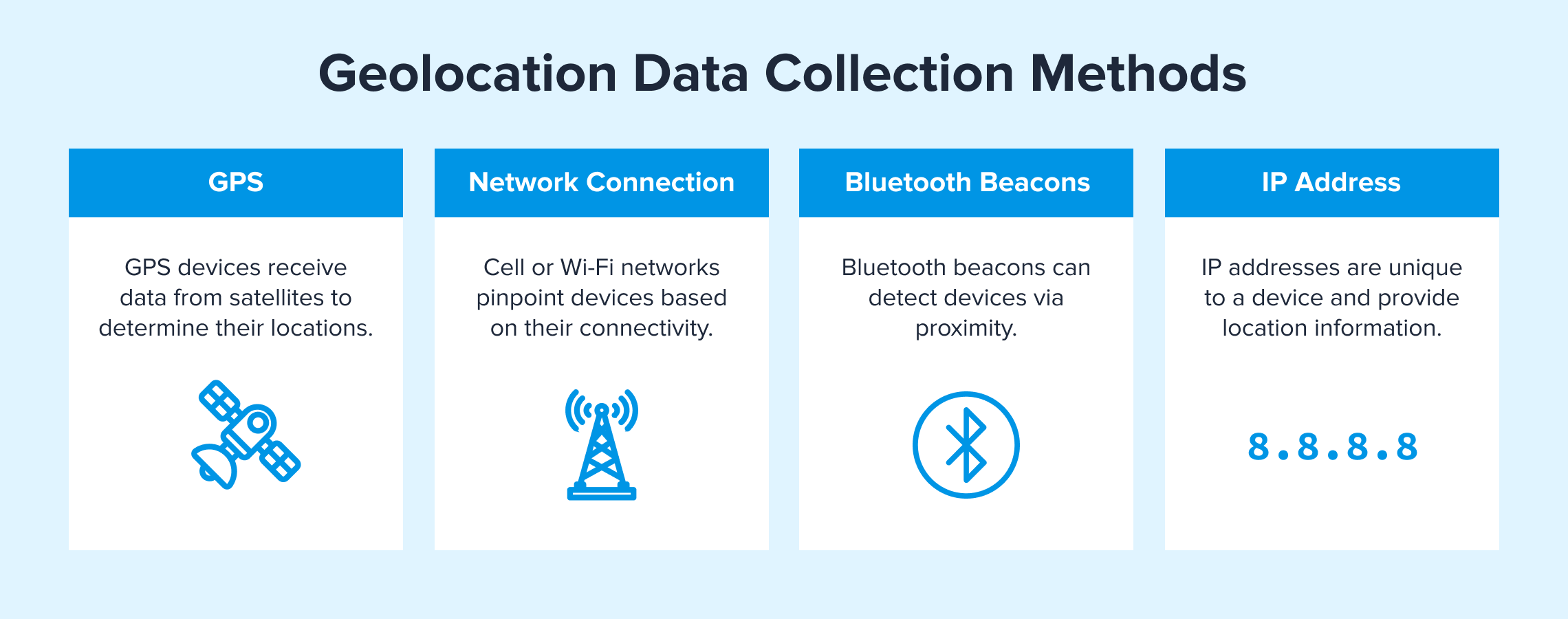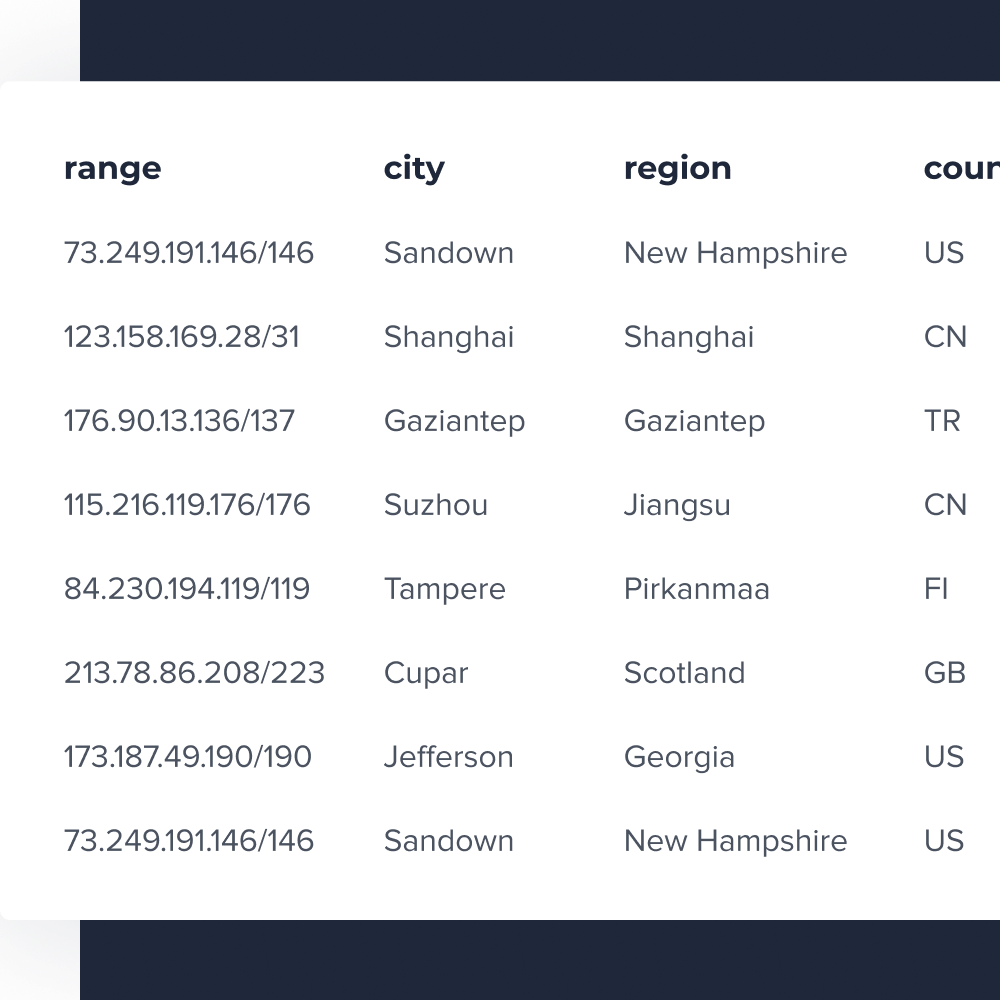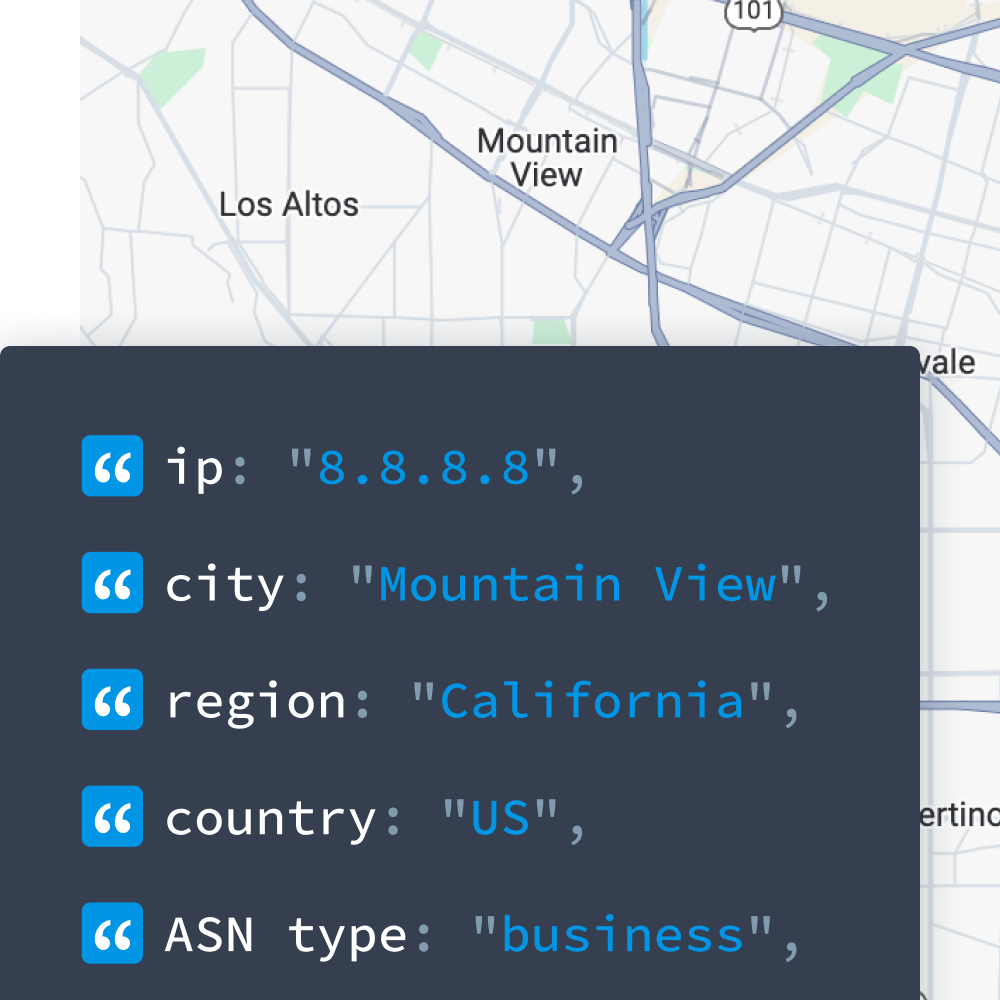 My IP ↗or
My IP ↗orDevice-Based Geolocation: Understanding Location Tracking

Device-based geolocation uses GPS, Wi-Fi, and cellular data to determine a device’s real-time location—with varying degrees of precision. In 2025, it continues to be essential for navigation, personalized user experiences, and location-based marketing. From getting turn-by-turn directions to receiving customized experiences based on location, geolocation powers many everyday digital experiences.
What Is Device-Based Geolocation?
Device-based geolocation is the process of determining a device’s physical location using technologies such as GPS, Wi-Fi, cellular networks, bluetooth beacons, or IP addresses.
GPS (Global Positioning System) relies on Global Navigation Satellite Systems (there are 31 satellites on medium earth orbit that provide GPS locations) to provide accurate location data with latitude and longitude coordinates, making it ideal for navigating between locations. Wi-Fi-based geolocation uses nearby Wi-Fi access points’ attributes, like network strength and device information, to determine where a device is located. Cellular network positioning estimates location based on signal strength and distance between cell towers and the device. Similarly, bluetooth beacons send out signals that determine signal strength and distance between them and the device.
IP addresses can also be used to determine geolocation, but the collection methodology is different, traditionally relying on generic self-published location data (such as WHOIS and geofeed), which is unregulated and provided voluntarily by ASNs. The most reliable IP geolocation providers offer additional data collection and validation processes to ensure geolocation accuracy.
These technologies are fundamental to many everyday services. Navigation apps like Google Maps use GPS to provide real-time directions. In emergency situations, geolocation helps first responders locate individuals in need of assistance. Businesses leverage location data for targeted advertising, ensuring users receive relevant offers based on their current location. Additionally, streaming platforms use geolocation for personalized content recommendations and compliance, ensuring that they only share content permitted in that country or region.
Types of Device-Based Geolocation

GPS
GPS geolocation determines a device’s position using signals from a network of satellites orbiting Earth. A GPS receiver calculates its exact location by measuring the time it takes for signals from multiple satellites to reach it. This system provides high accuracy, typically within a few feet, though factors like buildings, weather, and signal interference can affect precision. GPS is widely used for navigation, fleet tracking, outdoor recreation, and emergency response. It excels in open areas with a clear view of the sky, making it ideal for driving directions, hiking routes, and location-based services requiring real-time positioning.
Network Connection
Network connection geolocation determines a device’s location using Wi-Fi or cellular towers. Wi-Fi geolocation triangulates a device’s position based on nearby Wi-Fi networks, offering accuracy within a few feet, especially in urban areas where there are more networks. Cellular-based positioning estimates location using signal strength and proximity to cell towers, with accuracy ranging from a few hundred feet to several miles. This method is commonly used for location-based services, targeted advertising, and content localization when GPS is unavailable or less practical, such as indoors or underground.
Bluetooth Beacons
Bluetooth beacon geolocation uses small, low-energy transmitters that send signals to nearby Bluetooth-enabled devices, such as smartphones. These beacons broadcast unique identifiers, allowing apps or systems to determine proximity based on signal strength. Accuracy can range from a few inches to a few feet, making it highly precise for indoor navigation and location-based services. Bluetooth beacons are commonly used in retail for personalized marketing, in museums for interactive exhibits, and in airports or stadiums for wayfinding. Their ability to function indoors where GPS is unreliable makes them ideal for proximity-based experiences and real-time location tracking in enclosed spaces.
IP Address
IP addresses are unique digital identifiers for internet-connected devices. When a device connects to a website via an internet service provider, it shares its IP address with that site. Depending on the IP address data provider, geolocation is determined by WHOIS information along with routing information and other relevant data.
Unfortunately, that process is rife with issues since location data is provided voluntarily by autonomous system networks. Accuracy varies: at best, it can pinpoint a city or neighborhood, but it may only identify a general region or country. If a device travels from country to country, it could be days or even weeks before the geolocation is updated.
IPinfo, however, uses the same signal strength concept as other device-based geolocation services, relying on a proprietary Probe Network that uses ping and network attribute measurements from multiple server locations to determine a device’s location, ensuring a peerless level of IP address location accuracy. Learn more about our work enriching IP data.
IP address geolocation is commonly used for content localization, fraud detection, targeted advertising, compliance, and access control.

How to Get IP Geolocation Data
There are two main ways for companies and developers to get access to IP geolocation data: IP database downloads and APIs. Database downloads provide bulk access to data while the API offers real-time lookups. At IPinfo, either option provides granular details of every IP address, from accuracy radius to confidence level.
Compare data downloads vs. API.
IP Database Downloads
IP database downloads provide bulk geolocation data that businesses can store and use offline. These databases map IP addresses to locations, offering a scalable and high-performance solution for companies needing large-scale access to IP geolocation without relying on continuous API calls. However, they require regular updates to maintain accuracy, and their effectiveness depends on data freshness, integration capabilities, and update frequency, which vary across providers.
Pros:
- Offline accessibility – No internet connection is needed for lookups.
- Faster performance – Local lookups eliminate API call latency.
- Privacy control – No third-party access to sensitive data.
Cons:
- Storage requirements – Large databases take up disk space.
- Manual maintenance – Users must download, integrate and manage updates.
- Limited real-time accuracy – No instant updates for IP changes.
- Initial cost – Upfront purchase may be expensive for smaller businesses especially for OEM or comprehensive datasets.
Why IPinfo’s Databases Are a Better Solution
While most IP database providers offer static data dumps with predefined fields and limited update frequencies, IPinfo stands out with more accurate, frequently updated, and customizable datasets.
We offer unmatched accuracy with our Probe Network, which validates IP locations, delivering a higher level of precision than competitors. Our data is updated daily, weekly, and monthly, ensuring businesses always have the freshest geolocation data possible according to their needs. We provide automated dataset delivery, allowing businesses to choose local storage or access the database via flexible cloud integrations and receive daily database updates. We also enable businesses to define and add custom fields, ensuring maximum relevance and usability for specific workflows.
Get access to IPinfo’s downloadable IP database
Customize precise geolocation data to meet your specific business requirements.
IP Data API
IP data APIs provide real-time access to geolocation information, allowing businesses to retrieve updated IP address locations instantly without storing large datasets. APIs are ideal for dynamic applications needing up-to-date information, with simple integration into websites or apps. However, API-based geolocation solutions depend on internet connectivity and provider infrastructure, which can impact response times and availability.
Pros:
- Real-time data – Instant access to the most current geolocation information.
- Scalability – Easily handle increased demand as your business grows.
- Easy integration – Simple to integrate with existing systems.
- Reduced maintenance – The service provider handles data updates.
- Lightweight – No need for large storage capacity or offline management.
Cons:
- Dependency on internet connectivity – Requires a stable internet connection for access.
- Variable costs – API pricing is typically based on usage (queries per month), which may lead to variable costs compared to a fixed-price database.
- Latency concerns – API lookups introduce some response time delays, especially under heavy traffic, compared to local database queries.
- Rate limits & throttling – Some providers limit the number of requests per second, affecting applications with high-frequency lookups.
Why IPinfo’s API Is a Better Solution
While many IP data APIs offer standard geolocation lookup services, IPinfo sets itself apart with industry-leading speed, reliability, and enriched datasets.
We provide fast and reliable performance, delivering 50 to 200ms average response time for fast geolocation lookups, and 99.99% uptime, ensuring near-continuous availability even under high traffic loads. We offer superior accuracy with our Probe Network and continually evolve our data accuracy process for more precise IP geolocation data. Our API delivers more than just geolocation, offering detailed data including: ASN and ISP details, VPN and proxy detection, and company and carrier data. It’s also built for seamless integration, with complete documentation and fast onboarding.
Discover location-based data instantly with IPinfo’s IP address geolocation API
Get instant access to the quickest and most reliable solution for accessing geolocation context.
Device-Based Geolocation Tracking Use Cases
Here are some of the top use cases for device-based geolocation tracking across industries.
Targeted Advertising
Geolocation tracking enables businesses to deliver highly relevant ads by identifying a user’s location and tailoring content accordingly. By knowing where users are, companies can customize promotions to match regional preferences, showcase local deals, and serve ads that align with nearby events or businesses. This precision improves ad performance by reaching the right audience at the right time, increasing engagement and conversion rates.
Additionally, geolocation-based targeting helps reduce wasted ad spend by focusing only on relevant geographic areas. By leveraging location data enriched with contextual insights, businesses can filter out low-value or fraudulent traffic, ensuring that ads reach genuine users who are more likely to convert. This strategy not only enhances marketing efficiency but also sustains a personalized experience throughout the customer journey, ultimately boosting ROI and maximizing the impact of advertising budgets.
Explore the geolocation of most IPs.
Cybersecurity
Geolocation tracking enhances security by identifying and monitoring the geographic origins of network traffic, helping businesses detect and prevent fraud. By analyzing user locations, companies can flag suspicious activities, such as login attempts from unusual or high-risk regions, and take proactive measures like enforcing multi-factor authentication.
One key use case is detecting "impossible travel" scenarios, where a user appears to log in from distant locations within an unrealistic timeframe, signaling potential credential theft. Businesses can also use geolocation to block traffic from high-risk areas, preventing automated attacks like credential stuffing.
When combined with behavioral analytics, location data strengthens fraud models by detecting erratic IP shifts or suspicious access patterns. This proactive approach reduces security risks, protects sensitive systems, and ensures a safer online experience for users.
Web Personalization (Localization)
Geolocation tracking enables websites to map out geolocation of web visitors, then deliver personalized experiences by tailoring content based on a user’s location. By detecting where a visitor is accessing a site from, businesses can adjust language settings, display prices in the appropriate currency, and highlight region-specific product availability. This ensures a seamless and relevant browsing experience that enhances user engagement.
For example, an ecommerce site can showcase winter apparel for users in colder climates while promoting summer clothing in warmer regions. Similarly, businesses can promote local events, special offers, or store locations based on proximity. This localization strategy makes content more meaningful, driving higher interaction and conversions. By aligning offerings with local preferences, companies create a more intuitive user journey, strengthening customer relationships and fostering long-term brand loyalty.
Personalize your web content based on geolocation data
Present your brand so it's easier to understand, increases conversion rates, and improves your customers’ overall experience.
Compliance
Geolocation tracking helps organizations comply with legal and regulatory requirements by identifying user locations and enforcing region-specific policies. Businesses can use geolocation to restrict access to content or services in areas with legal constraints, such as blocking streaming platforms in countries without distribution rights or with laws that don’t allow certain types of content. Additionally, geolocation ensures compliance with data protection laws like GDPR in the European Union (EU) and CCPA in California by applying appropriate privacy policies based on a user’s location. Financial institutions also rely on geolocation to prevent unauthorized transactions and ensure services adhere to local regulations.
By enforcing licensing agreements and preventing unauthorized use in restricted regions, geolocation tracking strengthens data privacy and security while reducing legal risks. This proactive approach helps businesses avoid fines, protect sensitive information, and maintain compliance with global regulatory frameworks.
Geo-Blocking and Access Control
Geolocation tracking allows businesses to enforce geo-blocking and access control, creating virtual boundaries to deliver location-specific experiences and control access to certain sites and services. Streaming services use geofencing to enforce content licensing restrictions, ensuring shows and movies are only available in authorized regions. A food delivery service in Montreal can limit access to their services to IP addresses in that city so US-based users can’t make purchases.
In cybersecurity, companies restrict access to sensitive systems based on user location, preventing unauthorized logins and enhancing data protection. If an IP changes location frequently, a company can limit access. By implementing these location-based controls, companies enhance security, maintain regulatory compliance, and save time and money.
Wrapping Up Device-Based Geolocation Technology
Device-based geolocation is a powerful tool with diverse applications, from personalized marketing and enhanced security to regulatory compliance and operational efficiency. Businesses use IP geolocation in particular to deliver targeted ads, prevent fraud, enforce licensing restrictions, and optimize logistics.
When it comes to optimizing how your business uses IP geolocation data, IPinfo provides a hassle-free experience, offering precise IP data to power your location-based needs. Our unique approach to data accuracy ensures that companies get the clarity and intelligence they need to make better, smarter decisions. Data is available via scalable and high-performance database downloads or a fast, reliable API.
About the author

Meghan is the content strategist at IPinfo, where she develops and writes content for users to better understand the value of IP data and IPinfo products.


